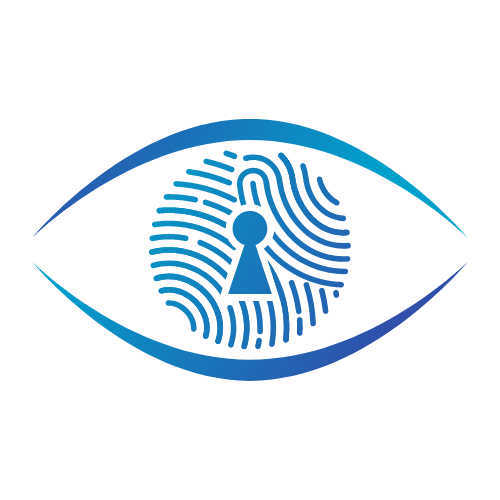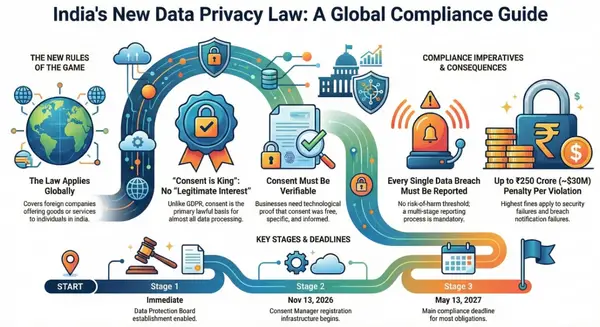ISO 27701: The Definitive Privacy Framework for Global Data Protection
Stay ahead of evolving compliance requirements with our comprehensive analysis of 2025 regulatory trends. This guide offers strategic insights and practical implementation steps for compliance professionals navigating today's complex regulatory landscape.

Introduction
In an era of expanding privacy regulations, organizations face the daunting challenge of navigating an increasingly complex global privacy landscape. As data breaches become more frequent and costly, and regulations like GDPR, CCPA, and emerging state privacy laws impose stricter requirements, businesses need structured frameworks to manage privacy compliance efficiently and effectively.
ISO 27701, published in 2019 as an extension to the well-established ISO 27001 information security standard, has emerged as a leading global framework for privacy information management. This comprehensive standard provides organizations with a systematic approach to managing personal data and demonstrating compliance with diverse privacy regulations.
This article explores ISO 27701's structure, implementation methodology, benefits, and strategic importance for organizations seeking to build robust privacy programs in 2025 and beyond.
Understanding ISO 27701
ISO 27701 (officially ISO/IEC 27701:2019) is an international standard that provides a framework for Privacy Information Management Systems (PIMS). It extends the ISO 27001 and ISO 27002 information security standards to encompass privacy management, creating a comprehensive approach to managing both security and privacy risks.
The standard was developed to address the growing need for organizations to demonstrate accountability in privacy management across multiple jurisdictions, providing a structured approach that can be mapped to various regulatory requirements worldwide.
Key Characteristics
- Extension of ISO 27001: Built upon the established Information Security Management System (ISMS) framework, making it easier for organizations already ISO 27001 certified to extend their compliance to privacy.
- Dual Roles Framework: Specifically addresses requirements for both data controllers (organizations that determine how personal data is processed) and data processors (organizations that process data on behalf of controllers).
- Global Applicability: Designed to work across jurisdictions, helping organizations address multiple regulatory requirements through a single management system.
- Risk-Based Approach: Follows ISO 27001's risk-based methodology, allowing organizations to tailor privacy controls based on their specific risk profile.
- Certification Option: Organizations can seek certification against ISO 27701, providing independent verification of their privacy management practices.
Core Components of ISO 27701
ISO 27701 is structured around several key components that together form a comprehensive privacy management framework:
1. PIMS-Specific Requirements
These requirements extend the ISO 27001 ISMS to address privacy management, including:
- Privacy policy development and implementation
- Privacy risk assessment methodologies
- Privacy impact assessments
- Privacy by design and by default principles
- Data subject rights management
- Breach notification procedures
- Data protection officer roles and responsibilities
- Cross-border transfer mechanisms
2. Controller-Specific Guidance (Annex A)
For organizations acting as data controllers, ISO 27701 provides specific guidance on:
- Lawful basis for processing
- Purpose limitation
- Data minimization
- Accuracy of personal data
- Storage limitation
- Consent management
- Transparency requirements
- Data subject rights fulfillment
3. Processor-Specific Guidance (Annex B)
For organizations acting as data processors, the standard addresses:
- Contractual measures with data controllers
- Processing limitations
- Data return and deletion procedures
- Sub-processor management
- Assistance with data subject requests
- Breach notification to controllers
- Processing records maintenance
4. Mapping to Privacy Regulations
ISO 27701 includes informative annexes that map its requirements to major privacy regulations:
- GDPR (General Data Protection Regulation)
- APEC Privacy Framework
- Various national privacy laws
This mapping helps organizations understand how implementing ISO 27701 can support compliance with specific regulatory requirements.
Implementation Methodology
Implementing ISO 27701 follows a structured approach, particularly for organizations that already have an ISO 27001-compliant ISMS in place.
For Organizations with Existing ISO 27001 ISMS
- Gap Analysis: Assess current privacy practices against ISO 27701 requirements to identify gaps.
- Scope Definition: Define the scope of the PIMS, which may align with or differ from the ISMS scope.
- Privacy Policy Development: Establish or update privacy policies to address ISO 27701 requirements.
- Risk Assessment Extension: Extend the existing risk assessment methodology to include privacy-specific risks.
- Control Implementation: Implement additional controls specified in ISO 27701 annexes.
- Documentation Update: Revise ISMS documentation to incorporate privacy management components.
- Training and Awareness: Conduct training for staff on privacy requirements and updated procedures.
- Internal Audit: Perform internal audits of the PIMS to verify effectiveness.
- Certification (Optional): Engage an accredited certification body for formal certification.
For Organizations Without ISO 27001
Organizations without an existing ISO 27001 ISMS will need to implement both standards simultaneously, which involves:
- Leadership Commitment: Secure executive support for the combined ISMS/PIMS implementation.
- Project Planning: Develop a comprehensive project plan for implementing both standards.
- Context Analysis: Understand the organization's context, including internal and external factors affecting information security and privacy.
- Scope Definition: Define the scope of both the ISMS and PIMS.
- Policy Development: Establish information security and privacy policies.
- Risk Assessment: Develop and implement risk assessment methodologies for both security and privacy risks.
- Control Selection: Select and implement controls from ISO 27002 and the ISO 27701 annexes.
- Documentation: Create comprehensive documentation for the management system.
- Implementation: Roll out the controls and procedures across the organization.
- Monitoring and Measurement: Establish metrics to evaluate the effectiveness of the management system.
- Management Review: Conduct regular management reviews of the system's performance.
- Certification (Optional): Pursue certification for both ISO 27001 and ISO 27701.
Strategic Benefits of ISO 27701 in 2025
Implementing ISO 27701 offers several strategic advantages for organizations navigating the complex privacy landscape of 2025:
1. Global Privacy Compliance Framework
As more countries and states implement privacy regulations, ISO 27701 provides a unified framework for addressing diverse requirements. By 2025, over 20 states in the U.S. will have comprehensive privacy laws, while countries across Asia, Latin America, and Africa continue to adopt GDPR-inspired legislation.
ISO 27701's mappings to these regulations help organizations maintain compliance across jurisdictions without implementing separate programs for each law.
2. Competitive Advantage
ISO 27701 certification demonstrates a commitment to privacy that goes beyond minimum compliance, providing a competitive edge in markets where privacy is increasingly valued by customers and partners.
Research indicates that by 2025, 75% of consumers will consider privacy practices in their purchasing decisions, making ISO 27701 certification a valuable market differentiator.
3. Third-Party Risk Management
As supply chain attacks continue to pose significant threats, ISO 27701 certification helps organizations demonstrate their privacy practices to customers and partners while providing a framework for assessing the privacy practices of their own vendors.
This is particularly important as regulatory requirements for vendor management become more stringent, with regulators increasingly holding organizations accountable for their suppliers' privacy practices.
4. Operational Efficiency
Rather than addressing each privacy regulation separately, ISO 27701 enables organizations to implement a single management system that addresses multiple compliance requirements, reducing duplication of effort and streamlining privacy operations.
This efficiency becomes increasingly important as privacy management resources remain constrained despite growing regulatory complexity.
5. Privacy by Design Implementation
ISO 27701 embeds privacy by design principles into organizational processes, ensuring that privacy considerations are integrated into products, services, and systems from inception rather than retrofitted later.
This approach not only improves compliance but also reduces the cost of addressing privacy issues that might otherwise be discovered late in development cycles.
6. Enhanced Accountability and Governance
The standard strengthens privacy governance through clear roles, responsibilities, and oversight mechanisms, helping organizations demonstrate accountability to regulators, partners, and customers.
With regulatory penalties increasing—GDPR fines reaching up to 4% of global revenue and U.S. state laws imposing penalties up to $7,500 per violation—strong governance is essential for risk management.
7. Risk Mitigation
By implementing a comprehensive set of privacy controls, organizations can significantly reduce the risk of privacy breaches, regulatory penalties, and reputational damage.
The average cost of a data breach involving personal information reached $4.45 million in 2023, with projections suggesting this could exceed $5 million by 2025, making preventive measures increasingly valuable.
ISO 27701 and Emerging Privacy Challenges
ISO 27701 provides a framework for addressing several emerging privacy challenges that organizations face in 2025:
AI and Algorithmic Privacy
As artificial intelligence and automated decision-making become more prevalent, ISO 27701 helps organizations:
- Implement privacy by design in AI systems
- Conduct privacy impact assessments for algorithmic processing
- Establish transparency in AI-driven decisions
- Manage consent for AI training and processing
- Address data minimization in machine learning contexts
Cross-Border Data Transfers
With continuing uncertainty around international data transfers following the invalidation of various mechanisms like Privacy Shield, ISO 27701 supports:
- Implementation of appropriate safeguards for transfers
- Documentation of transfer impact assessments
- Contractual measures to protect transferred data
- Monitoring of changing transfer requirements
Biometric Data Protection
As biometric authentication becomes more common, ISO 27701 addresses:
- Special category data management
- Enhanced security measures for biometric information
- Consent management for biometric processing
- Data minimization principles for biometric systems
Privacy in Remote Work Environments
The permanent shift to hybrid work models creates new privacy challenges that ISO 27701 helps address:
- Boundary management between work and personal activities
- Employee monitoring limitations and transparency
- Remote access security with privacy considerations
- Data protection in distributed work environments
Challenges in ISO 27701 Implementation
While ISO 27701 offers significant benefits, organizations should be aware of potential implementation challenges:
1. Resource Requirements
Implementing a comprehensive PIMS requires dedicated resources, including privacy expertise, time, and budget. Organizations should plan accordingly and consider phased implementation approaches.
2. Integration with Existing Compliance Programs
Organizations with established privacy compliance programs need to carefully integrate ISO 27701 requirements without disrupting existing processes or creating duplicative efforts.
3. Scope Determination
Defining the appropriate scope for ISO 27701 certification can be challenging, especially for large organizations with diverse data processing activities. Too narrow a scope limits value, while too broad a scope may be unmanageable.
4. Maintaining Current Mappings
As privacy regulations evolve, organizations must continuously update their understanding of how ISO 27701 maps to new requirements, potentially requiring more frequent system reviews than the standard three-year certification cycle.
5. Supply Chain Management
Extending privacy requirements to suppliers and partners can be challenging, particularly when working with organizations that lack mature privacy practices or ISO 27701 certification.
Best Practices for Success
To maximize the value of ISO 27701 implementation, organizations should consider these best practices:
1. Executive Sponsorship
Secure C-level support for the implementation, emphasizing both compliance benefits and business advantages such as customer trust and competitive differentiation.
2. Cross-Functional Approach
Establish a cross-functional team including legal, IT, security, compliance, business units, and executive leadership to drive implementation and ensure organizational alignment.
3. Integration with Security Programs
Leverage existing information security programs and ISO 27001 controls when implementing ISO 27701 to avoid duplication and maximize efficiency.
4. Phased Implementation
Consider a phased approach, beginning with high-risk processing activities or business units before expanding to the entire organization.
5. Regular Assessment
Implement continuous monitoring and periodic reassessments to ensure the PIMS remains effective as privacy risks and regulations evolve.
6. Technology Enablement
Leverage privacy management technologies to automate aspects of the PIMS, including data mapping, consent management, and data subject request fulfillment.
7. Training and Awareness
Develop comprehensive training programs to ensure all employees understand their roles in maintaining privacy compliance under the ISO 27701 framework.
Case Studies
Financial Services Institution
A global financial services firm implemented ISO 27701 to address multiple regulatory requirements across 30+ jurisdictions. By mapping the standard to GDPR, CCPA, LGPD, and various APAC privacy laws, the firm reduced compliance costs by 35% while improving their ability to enter new markets quickly.
Healthcare Technology Provider
A healthcare SaaS provider achieved ISO 27701 certification to demonstrate privacy compliance to healthcare clients. The certification helped the company win contracts with privacy-sensitive European healthcare organizations, growing their international revenue by 40% over two years.
Manufacturing Conglomerate
A multinational manufacturing company used ISO 27701 to standardize privacy practices across diverse business units operating under different regulatory regimes. The implementation enabled centralized governance while allowing flexibility for local regulatory variations, reducing privacy incidents by 60%.
Future Outlook
As the privacy landscape continues to evolve, ISO 27701 is likely to adapt and expand. Future developments may include:
- Enhanced guidance for AI and machine learning privacy
- Updates to address quantum computing security implications
- Expansion of cross-border transfer mechanisms
- Integration with emerging industry-specific privacy standards
- Alignment with evolving regulations like the EU AI Act
Organizations that implement ISO 27701 now will be better positioned to adapt to these changes, leveraging their established PIMS to incorporate new requirements as they emerge.
Conclusion
ISO 27701 represents a significant advancement in privacy management standardization, offering organizations a comprehensive framework for addressing the complex privacy challenges of 2025 and beyond. By extending the established ISO 27001 information security standard to encompass privacy management, ISO 27701 provides a structured approach that scales across jurisdictions and adapts to evolving regulatory requirements.
For organizations seeking to demonstrate privacy accountability, streamline compliance efforts, and build trust with customers and partners, ISO 27701 offers a valuable foundation. While implementation requires commitment and resources, the benefits—including operational efficiency, risk reduction, and competitive advantage—make it a strategic investment for privacy-conscious organizations.
As privacy continues to gain importance as both a compliance requirement and a business differentiator, ISO 27701 stands as a definitive global standard for privacy management excellence.





